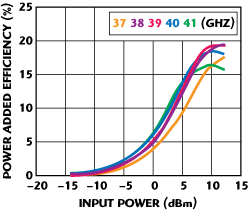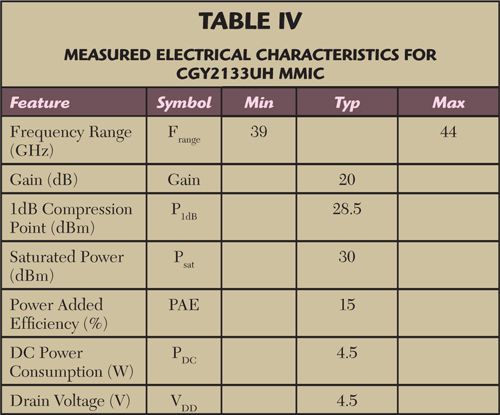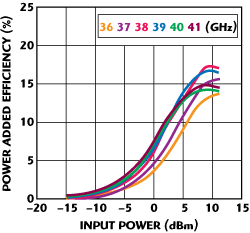 The requirements for higher and higher data rates and the saturation of existing frequencies and networks are pushing applications higher and higher in frequency. This is true for both the "traditional" frequency bands around 38 GHz, but also at frequencies higher than 40 GHz. This movement has been consolidated by the authorization of the 40.5 to 43.5 GHz band in Europe and elsewhere for telecommunications. Today, this spectrum is under-used and several companies are introducing systems to provide 100+ Mb/s transmission rates. Even higher frequencies are also being considered, including the 71 to 76 GHz and 81 to 86 GHz bands. As well as terrestrial links there are similar requirements for satellite links.
The requirements for higher and higher data rates and the saturation of existing frequencies and networks are pushing applications higher and higher in frequency. This is true for both the "traditional" frequency bands around 38 GHz, but also at frequencies higher than 40 GHz. This movement has been consolidated by the authorization of the 40.5 to 43.5 GHz band in Europe and elsewhere for telecommunications. Today, this spectrum is under-used and several companies are introducing systems to provide 100+ Mb/s transmission rates. Even higher frequencies are also being considered, including the 71 to 76 GHz and 81 to 86 GHz bands. As well as terrestrial links there are similar requirements for satellite links.
OMMIC has been very active in providing standard products at lower frequencies while enabling its customers access to the technologies under a "Foundry Service" for the higher frequencies. The company is now actively developing power amplifier MMICs to cover applications from 20 to 86 GHz. In particular, a family of four new products—the CGY2130UH, CGY2131UH, CGY2132UH and CGY2133UH power amplifiers—has been developed that between them cover 37 to 43 GHz and provide 500 mW and 1 W output power.
Technology
To have a good power amplifier at these higher frequencies requires a different trade-off of parameters than for the traditional lower frequency MMIC technologies. While high current (IDSmax) and breakdown voltages (VBGD, VDSmax) are required, it is also essential to have high cut-off frequencies (Ft, Fmax). OMMIC has developed a short gate length, high Ft process called the D01PH.
Developed originally for the fiber optic driver market, this technology has an excellent trade-off between its breakdown voltage (11 V) and its very high Ft (105 GHz) and Fmax. This allows high gain, high output power and good power added efficiency (PAE) from power amplifiers even at 43 GHz. On-wafer load pull measurements at 40 GHz have demonstrated 500 mW (at 1 dB compression point) per mm of gate width, which is compatible with the fabrication of MMICs with output powers up to 4 W.
The PHEMT process has a 0.13 µm T-gate, a double recess and offset drain-source spacing. The MMIC process includes all normal passive components such as epitaxial and NiCr resistors, spiral inductors, airbridges and via holes. The substrate height is 100 µm to maximize overall production yield.
The process has been available for more than 10 years and has been successfully evaluated by the European Space Agency and is on the European Preferred Parts List. Ongoing developments with this process include the design and fabrication of space qualified 20 GHz, 2 W devices specifically for the European space industry.
500 mW MMICs
The CGY2130UH and the CGY2131UH are the two new 500 mW MMICs. The first power amplifier covers the band 37 to 41 GHz, while the second from 39 to 44 GHz. Both devices operate from a relatively low drain voltage of 4.5 V, but exhibit excellent PAE of over 15 percent. The performances of the two devices are shown in Tables 1 and 2, respectively. The design is based around classic power combining networks with an optimal choice of transistor size per section for the linearity and power added efficiency. A total of three stages of amplification are used to achieve 22 dB of gain and an output power of over 500 mW.



Figure 1 Measured electrical characteristics for CGY2130UH at 4.5 V.

Figure 2 Measured PAE vs. input power and frequency for CGY2130UH.
Figure 1 shows the measured 1 dB compression point, saturated output power and small-signal gain versus frequency for the CGY2130UH at 4.5 V. The performance presented here is for nominal biasing, measured in CW mode and are on-wafer measurements, which are not optimal for thermal dissipation. Figure 2 represents the measured power added efficiency for the CGY2130UH versus input power for a range of frequencies.
It can be seen that a high gain (22 dB) with good PAE (17 percent) is achieved and over a wide bandwidth too. The performance of the CGY2130UH and CGY2131UH is such that they are very suitable for applications in the 37 to 44 GHz frequency bands and cover many different applications over these bands. For both the CGY2130UH and the CGY2131UH the measured output IP3 is 34.5 dBm, measured under nominal biasing conditions.
1 W MMICs
Two 1 W MMICs have been launched for the same frequency bands: The CGY2132UH, which operates from 36 to 41 GHz, and the CGY2133UH from 39 to 44 GHz. Similar building blocks have been used as for the 500 mW MMIC with the addition of Lange couplers at the input and output as power splitters and combiners. This results in an excellent and wideband input and output match and the possibility to match the impedance of the last stage for maximum power and PAE. A total of three stages of amplification are used to achieve 20 dB of gain and a saturated output power of 1 W.



Figure 3 Measured on-wafer electrical characteristics for CGY2132UH at 4.5 V.

Figure 4 Overall PAE vs. input power and frequency for CGY2132UH.
The specification of each device is presented in Tables 3 and 4; both devices have saturated output powers of 30 dBm with 20 dB of small-signal gain when biased from a 4.5 V supply. Figure 3 shows the measured on-wafer 1 dB compression point, saturated output power and small-signal gain versus frequency for the CGY2132UH at 4.5 V.
Again it should be noted that the results presented are for the worst-case on-wafer non-pulsed CW measurement conditions; the same MMICs mounted with good thermal conditions have been shown to have typically 1 dBm higher output compression point. Figure 4 shows the overall power added efficiency of the CGY2132UH. The measured output IP3 for the 1 W device is typically found to be the P1dB plus 8 dB (37 dBm).
To simplify the use of the devices over multiple platforms, the CGY2132UH and CGY2133UH have common dimensions and pad positioning, again positioning the two amplifiers for many different terrestrial and satellite applications in the 36 to 44 GHz bands.
Conclusion
Four new MMICs provide 500 mW and 1 W of output power up to 44 GHz and provide a very versatile power amplifier line up over the 36 to 44 GHz frequency bands. Excellent power added efficiency and high gain are obtained for the four MMICs and all use a qualified and proven process from OMMIC"s own foundry. Ongoing product development includes completing the product range with new 2 and 4 W devices in the 36 to 44 GHz frequency range, as well as extending the company"s power amplifier product range to the new 71 to 76 GHz and 81 to 86 GHz bands.
OMMIC,
Paris, France,
Tel: +33 (0)1 4510 6731,
Fax: +33 (0)1 4510 6953,
E-mail: information@ommic.com, www.ommic.com.
RS No. 302
